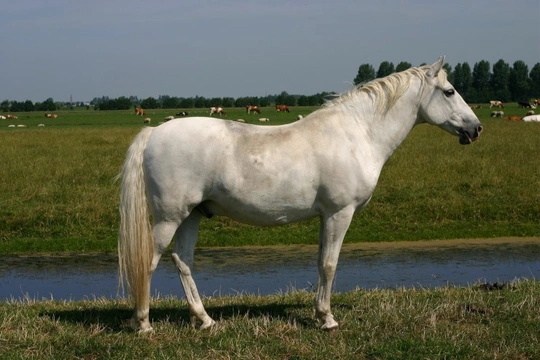
Melanomas in Grey Horses
Everyone loves a grey horse, beloved of racing pundits as, ‘the housewives choice’ and captured in folklore and mythology as something other worldly and magical, the old-fashioned sales advice was, ‘always look twice at a grey horse’. This is because the colour will often distract the viewer from conformational or other issues which may be relevant, lost in marvel at the wonderful colour.
But grey horses can suffer from melanomas and that is one thing that does set them apart from other colours and not for a good reason. Melanomas are most commonly, although not exclusively, associated with grey horses of a certain maturity. Over 80% of grey horses over fifteen years of age will have some melanomas.
An equine melanoma is a tumour which results from the abnormal and uncontrolled growth of melanocytes which are the cells that produce skin pigment. The vast majority of growths begin as small, nodular lumps which develop slowly throughout the life of the horse, sometimes joining together to form larger, concentrated masses. They don’t always cause problems as usually, these tumours are benign in nature but this depends to some extent on their location. One or more of the tumours will develop malignancy with age and they can locally cause problems, for example under the tail, where they can constrict the area and make it difficult for the horse to pass manure. The most common area for the growths to develop is under the tail/dock area of the horse, the sheath on geldings and on the head behind the jaw bone and under the ears. But they can appear almost anywhere on the body. Interestingly, melanomas in horses which do not have a grey coat colour are usually always malignant.
Most horses happily co-exist with their melanomas for years before they cause a problem if they do at all. Often other age-related issues or injuries intervene in the life of the horse. Melanomas can prove troublesome if they are found on parts of the horse where tack is fitted such as the saddle area and in these circumstances, may be surgically removed. Large clusters of nodules under the tail may prove tricky to manage as they can rub and ulcerate and form a great attraction flies which can cause infection so these horses will require some fairly proactive fly management during the summer months.
Treatment for melanomas
There is no specific treatment or cure for melanomas. The prevailing view amongst the veterinary profession for many years has been to leave them alone if not causing trouble as interference with a tumour may cause it to spread.
Sometimes small nodules, particularly those that are causing problems, are removed by either surgical intervention or cryosurgery which is where the tumours are frozen off with liquid nitrogen. There is no chemotherapy as such to treat these masses. The cause of melanomas in grey horses is not yet understood but is not thought to be linked to exposure to sunshine as is the case in people. It is quite remarkable that there has been very little research into the cause and treatment of this disease which affects such a high proportion of grey horses. Breeds such as Percherons have a very high preponderance of the issue because the majority of the horses are grey in colour so it is surprising that the veterinary profession and pharmaceutical industry have been so slow to look for treatment options.
Recently, however, there has been some movement on the research front. Melanomas are also a problem in dogs and vets in the US have had some success in using a vaccine to treat melanomas which can shrink the tumours and slow their development.
The horse’s body has never recognised melanoma cells as abnormal and so has not responded to them in the same way that it would to a virus or bacteria. However, melanoma cells have a large amount of an enzyme called Tyrosinase. This enzyme controls the horse’s production of melanin and therefore melanoma which is the end product of uncontrolled melanin production. Tyrosinase is a normal enzyme found in the body so inducing an immune response has been very challenging.
Development of a vaccine in dogs has managed to effectively trick the animal’s body into producing an immune response against the melanoma cells and this science is now being used in equines with some promising results. The vaccine administered by a course of injections will act upon all the tumours in the body. Whilst this is not a cure for melanomas, early treatments indicate that it will certainly arrest the growth of these nodules in a percentage of horses and in some cases, actually instigate a regression. The Animal Health Trust in Newmarket is now offering this vaccine to owners and there is a large clinical trial underway in America to take a closer look at how effective this really could be for the large population of grey horses.



